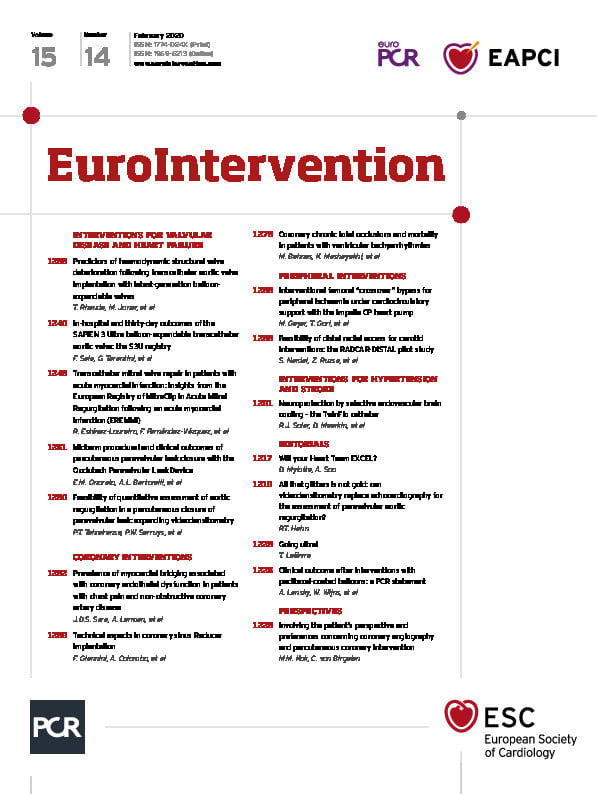
A team-based approach has been successfully applied to many branches of medicine, perhaps most notably in cancer care, and has been used with increasing frequency in cardiovascular medicine. In our specialty, the Heart Team concept emerged after the publication of the Synergy Between PCI With Taxus and Cardiac Surgery (SYNTAX) trial1. The Heart Team has become even more prominent since the introduction of transcatheter aortic valve implantation (TAVI) and the application of various transcatheter solutions in structural heart disease. It is intuitively understood that complex case management will benefit from the involvement of multiple specialists, each with in-depth knowledge of treatment strategies and recent advances in their area of clinical practice. Hence, our clinical practice guidelines have enshrined the Heart Team as the final arbiter of treatment allocation in patients with complex coronary or structural heart disease (as opposed to SYNTAX or STS scores)2.
It is interesting to consider that the origins of the Heart Team in the fields of coronary artery and structural heart disease emerged from advances in device technology (drug-eluting stents [DES] and TAVI, respectively). In the early years of TAVI, the Heart Team functioned largely to select inoperable and high-risk cases that could be suitable for the nascent transcatheter technology. Both regulators and payers mandated this Heart Team. More recently, as the evidence base for the application of TAVI to lower-risk patients has accumulated, a different Heart Team (2.0) has emerged. This team now has to make more nuanced treatment allocation decisions for younger and older patients across the aortic stenosis risk spectrum. These decisions are informed by short- to medium-term randomised controlled trial (RCT) data, and team members must consider important patient variables such as frailty, concomitant disease, and anatomy. In essence, a real Heart Team has emerged. Participating physicians mandate this Heart Team as its value to patient care is obvious.
This real Heart Team functions because of the personal and professional relationships and mutual respect that underpin it. Shared decision making requires collaboration, trust, and shared experiences. Togetherness and cohesion characterise a functional team. In contrast, dysfunctional teams are universally characterised by mistrust, suspicion and poor communication3. Recent events surrounding the publication of the 5-year data from the EXCEL trial in the New England Journal of Medicine should therefore serve as a reminder that the collegial nature of a Heart Team should not be taken for granted4. The execution, results, or interpretation of the EXCEL trial, and the allegations made with respect to the conduct of the trial, are not the subject of this editorial. It is manifest that interventional cardiologists, cardiac surgeons, payers, the medical device industry and, most importantly, our common patients, stand to benefit from a rigorous and transparent scientific appraisal of the EXCEL trial results. Of considerable concern, however, is the undercurrent of tribalism and professional mistrust between interventional cardiologists and cardiac surgeons and their respective organisations that has emerged in the wake of the EXCEL affair.
We should be cognisant that most clinical trials have flaws and limitations and that highly selected trial populations rarely represent patients encountered in day-to-day clinical practice. Even well-designed and well-executed clinical trials with reliable and unambiguous results can be challenging to interpret. The recently published PARTNER 3 trial5, which compared surgical and transfemoral balloon-expandable TAVI in low-risk (N=1,000; STS <4%) symptomatic aortic stenosis patients, is one such example. The primary endpoint of this trial, a composite of death, stroke and rehospitalisation at one year, was significantly lower with TAVI compared to surgery (8.5% vs 15.1%; absolute difference −6.6 percentage points; 95% confidence interval [CI]: −10.8 to −2.5; p<0.001 for non-inferiority; hazard ratio 0.54; 95% CI: 0.37 to 0.79; p=0.001 for superiority). Although seemingly clearly in favour of TAVI, several important issues should temper our enthusiasm for the transcatheter therapy: only one quarter of patients were <75 years old; 33% of screened patients were excluded (most due to anatomy precluding safe TAVI); multivalve and severe coronary artery disease, bicuspid morphology, low flow aortic stenosis and non-femoral TAVI were not enrolled. It therefore falls to the Heart Team to interpret these data together and to agree a common path to integrate this new information into their local practice.
The EXCEL trial has informed our understanding of how to treat patients with left main disease. It will continue to do so. While concerns regarding the conduct of the trial and interpretation of the results are legitimate and require scrutiny, we must not allow the debate surrounding this trial to descend into tribalism and suspicion. It must not become a turf war which would threaten the very fabric of the Heart Team. Cardiology and cardiac surgery are specialties that tend to attract passionate and committed doctors. We must remain mutually respectful and remember to put our patients at the heart of our discussions and treatment decisions. In this respect, we must EXCEL!
Conflict of interest statement
The authors have no conflicts of interest to declare.
Supplementary data
To read the full content of this article, please download the PDF.

